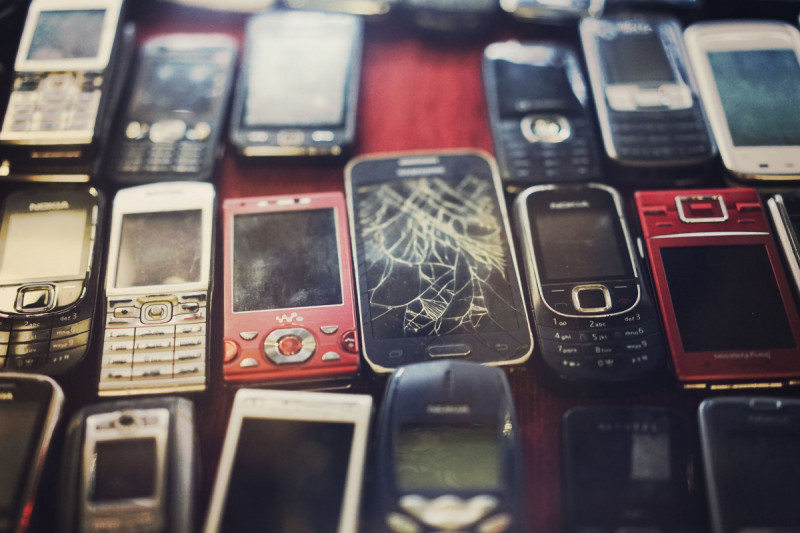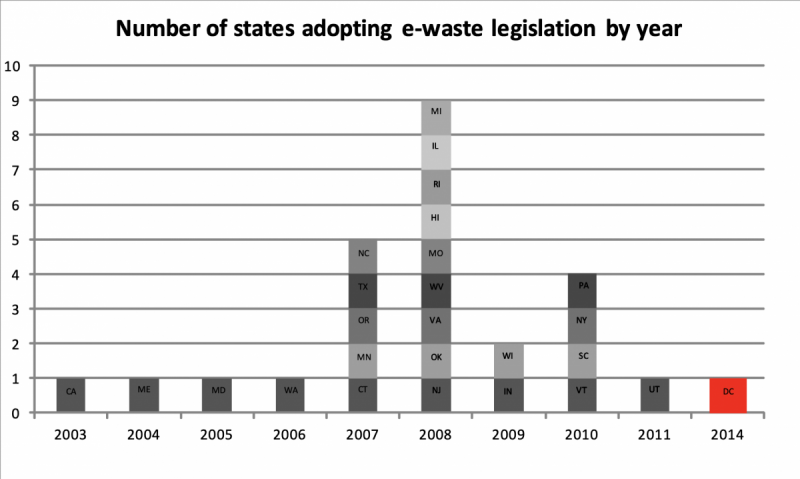Where do DC’s electronics go when they die?

E-waste by andreahuyoff used with permission.
As District residents prepare for Thanksgiving and the subsequent Black Friday and Cyber Monday, many will be thinking about upgrading to new gadgets. Less discussed at the family Thanksgiving meal, however, is what we do with all the electronic devices we toss away, otherwise known as e-waste. While electronics were finally banned from DC’s waste stream in 2018, there’s considerable work to be done on e-waste if the District wants to meet its goal of diverting 80% of solid waste by 2032.
E-waste is now the fastest-growing global trash stream as Americans increasingly own and discard gadgets. In 2013, the average American household owned approximately 24 electronic products. According to the Global E-Waste Monitor, U.S. consumers generated almost 7 million tons of e-waste in 2019 alone (the current EPA estimate is closer to 3 million tons but only includes selected electronics). But e-waste recycling has not caught up with consumer demand — with estimated recycling rates between 15% and 36%, most e-waste ends up in the dump.
DC’s electronics recycling program, eCYCLE DC, collected more than 970 tons of e-waste for recycling in 2017. While we know that e-waste is growing across the country, it’s hard to find data on DC’s situation. Since the last DC residential waste sort was done in 2007, it’s hard to gauge exactly how much electronic waste is entering the local waste stream. But according to eCYCLE’s 3-year assessment, more drop-off options are needed for District residents.
In DC, convenience continues to be a major issue. Given the need to address e-waste, in February 2020, DC announced plans to double its e-cycling efforts, including service in Department of Parks and Recreation (DPR) recreation centers and DC Libraries. Unfortunately, the plan was derailed by the pandemic when most DC facilities were closed.
Presently, District residents can drop off unwanted electronic equipment every Saturday at the Fort Totten Transfer Station or sporadic library drop-offs. Lately, long lines have plagued the Fort Totten Transfer Station, threatening to take up a good part of a resident’s day.
A timeline of e-waste legislation in the US by the author.
The District is not alone in facing challenges disposing of electronics. To date, no federal law requires the recycling of e-waste. Other jurisdictions are struggling with convenient ways to collect and properly dispose of or recycle e-waste. Urban areas like Staten Island in New York City are having the same problems of limited options and budget shortfalls.
E-waste isn’t just taking up space in landfills. Electronics can have toxic additives or other hazardous substances, such as mercury, lead, or flame retardants, posing a major health and environmental hazard in landfills and impacting groundwater and animals. Recent studies have also found evidence of health effects from e-waste exposure in both children and adults, ranging from thyroid dysfunction to changes observed at the cellular level.
One promising avenue is repairing, repurposing, reusing, upcycling and salvaging valuable parts. Given the gold, silver, and copper in products, some municipalities are reframing e-waste as a resource instead of a problem, recognizing the value in extracting metals from e-waste as a more cost effective and environmentally friendly method than mining virgin materials.
Nationally, EPA is trying to tackle this issue with improved management of electronics throughout the product lifecycle with the National Strategy for Electronics Stewardship.The agency touts the strategy as a way to “create green jobs, lead to more productive reuse of valuable materials, and support a vibrant American recycling and refurbishing industry.”
In the meantime, as the lifespan of our technology shrinks but its importance in our lives grows, the District will need to work hard to make sure all those discarded electronics have an environmentally sustainable place to go.
